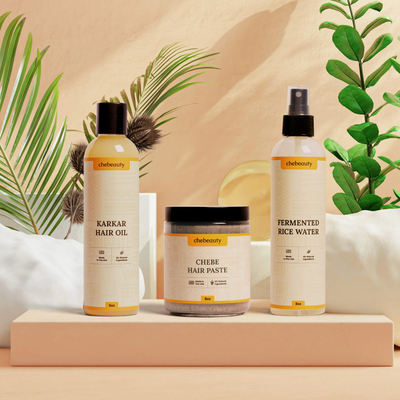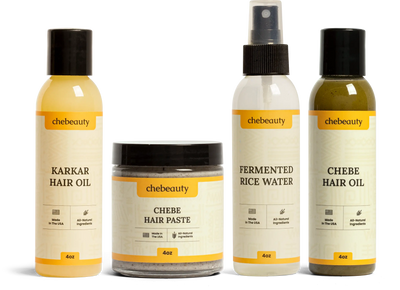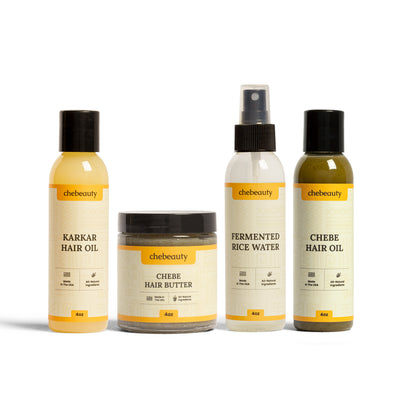In the diverse landscape of hair care traditions, of the few unique cultural practices that have stood the test of time, Chebe has been the one most on the rise in the recent hair care trends. Originating from the Republic of Chad in Africa, Chebe has a rich history intertwined with cultural significance and traditional hair care practices. This article delves into the journey of Chebe, exploring its origins, cultural applications, evolution in modern times, and the ongoing efforts to preserve its traditions.
Uncovering the Origins of Chebe
Historical Background of Chebe
The history of Chebe can be traced back centuries, with its roots embedded among the Chadian tribes. The Chadian women, known for their lush and healthy hair, often attribute their enviable locks to the use of Chebe.
In fact, this natural hair care solution gained prominence as a cherished family secret, passed down through generations. In fact, there is still a tradition of making Chebe together as a village, whereby each woman shares her own unique recipe with either her daughters or granddaughters to pass down the knowledge of a particular family recipe.
Traditional Uses and Significance
Chebe, derived from the Lavender Croton plant, is traditionally mixed with other natural ingredients to form a potent hair care concoction. The application process is meticulous, involving a unique ritual that has been preserved through oral traditions. The significance of Chebe extends beyond aesthetics; it symbolizes a connection to heritage and the cultural identity of the communities that practice its use.
Chebe in Cultural Hair Care Practices
Rituals and Methods of Application
Application of Chebe Mixed with Oil
The application of Chebe mixed with oil is a meticulous process deeply ingrained in the cultural practices of the Chadian tribes. The first step involves combining Chebe powder with a chosen oil to create a nourishing paste. The amount of Chebe powder you wish to mix with oil depends entirely on the texture you are going for, though generally, 4 tablespoons of Chebe powder and 2 tablespoons of oil would be more than enough.
Once the Chebe and oil blend is ready, the application process begins. Women carefully coat their hair with the paste, ensuring that every strand is covered. The ritual doesn't end there; specific styling methods are employed to secure the mixture in the hair. The intent is to allow the nutrients from the Chebe to penetrate the hair shaft, promoting strength, moisture, and overall hair health.
Application of Chebe Mixed with Butter
In addition to the oil-based application, another cherished method involves mixing Chebe with natural butters like shea or cocoa - or even better yet, Chebe butter. This variation adds an extra layer of richness to the concoction. The butter is combined with Chebe powder in a ratio of 4 tablespoons of powder to 1-2 tablespoons of butter depending on preferred consistency to create a luxurious, thick paste,
Application of Chebe mixed with butter follows a similar process to the oil-based method. The paste is generously applied to the hair, ensuring thorough coverage. The combination of Chebe with butter enhances the moisturizing properties, leaving the hair feeling exceptionally soft and supple.
The Role of Chebe in Community and Identity
Chebe extends beyond individual care; it plays a crucial role in community bonding and identity. The sharing of Chebe recipes and application techniques is a communal activity, fostering a sense of unity among women. The tradition is passed down from mothers to daughters, reinforcing the cultural fabric of these societies.
The Evolution of Chebe in Modern Hair Care
Adapting Traditional Practices
As the allure of traditional remedies permeates the global beauty landscape, Chebe has gracefully transitioned from a regional secret to a sought-after ingredient in modern hair care. The adaptation of traditional Chebe practices to contemporary routines reflects a harmonious blend of ancient wisdom and modern convenience.
Embracing Global Appeal
Chebe's journey into modern hair care routines is marked by its universal appeal. Beauty enthusiasts worldwide have embraced the natural properties of Chebe, recognizing its potential to address the challenges of modern-day hair care. The adaptability of Chebe allows individuals from diverse backgrounds to incorporate a piece of Sahelian heritage into their beauty regimen.
DIY Recipes and Online Communities
The digital age has played a pivotal role in the adaptation of Chebe into modern hair care. DIY enthusiasts share recipes, application techniques, and personal experiences on online platforms, creating a global community connected by their love for natural remedies. This exchange of knowledge transcends geographical boundaries, allowing individuals to customize Chebe applications based on their unique hair needs.
Chebe's Place in Contemporary Hair Care
As Chebe cements its place in contemporary hair care, it goes beyond being a mere ingredient and transforms into a symbol of authenticity and sustainability. In a beauty landscape increasingly characterized by a demand for transparency, Chebe's natural origin aligns perfectly with the growing preference for clean and ethically sourced products. Consumers are drawn to the simplicity and purity of Chebe, appreciating its minimal environmental impact compared to synthetic alternatives.
Moreover, Chebe's cultural roots add a layer of storytelling to modern beauty routines, inviting users to connect with a tradition that spans generations. In this way, Chebe not only enhances the health of hair but also contributes to a broader narrative of conscious and culturally enriched beauty practices.
Preserving and Celebrating Chebe Traditions
Efforts to Maintain Cultural Heritage
In an era marked by rapid globalization, preserving cultural heritage becomes paramount. Various initiatives have emerged to safeguard the traditions associated with Chebe. Local communities, along with governmental and non-governmental organizations, are actively engaged in documenting and promoting the use of Chebe as an integral part of their cultural identity.
There are also companies, which actively go out of their way to introduce Chebe’s legacy to the Western world and preserve it in that way. Chebeauty is a great example of such a company that cooperates with locals for ingredients and recipes, while manufacturing the products according to the best US practices and standards.
Embracing Chebe in Today's World
While the use of Chebe has evolved, efforts are underway to ensure that the core values and rituals associated with its application remain intact. Educational programs, cultural festivals, and online platforms play a crucial role in promoting awareness and understanding of Chebe, encouraging individuals to embrace this traditional practice with respect and authenticity.
Learning from the Past: Chebe's Enduring Legacy
As we reflect on the history and tradition of Chebe, it becomes evident that its enduring legacy is more than a beauty secret; it is a testament to the resilience of cultural practices. Chebe serves as a bridge between generations, connecting individuals to their roots and fostering a sense of pride in cultural identity. In a world where trends come and go, Chebe stands as a timeless tradition, offering valuable lessons in the preservation of cultural heritage.
Conclusion
Chebe's journey from a regional secret to a global phenomenon showcases the power of cultural practices in shaping beauty traditions. As we continue to explore the depths of traditional wisdom, embracing the significance of Chebe in our hair care routines allows us to connect with the rich tapestry of human history. Let us celebrate and honor the cultural roots of Chebe, recognizing its enduring legacy and the profound impact it continues to have on hair care practices worldwide.





























